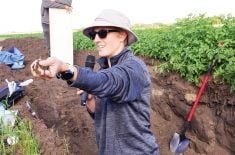KELOWNA, B.C. – Seed growers in Saskatchewan and Manitoba are beginning to assess the impact of the rain-soaked 2010 production season and so far, the results don’t look encouraging.
Pedigreed seed acreage is down significantly in some parts of Saskatchewan and Manitoba and seed growers in those areas are already anticipating short supplies of certified seed, especially for flax and new cereal crop varieties.
Lyndon Olson, president of the Saskatchewan Seed Growers Association, says the fallout will be hard to gauge until crops mature and a more complete picture emerges.
Read Also

Soybean market still figuring out implications of China-U.S. pact
Soybean futures had a muted reaction to the U.S. trade deal with China as the market tries to figure out the nuances of the deal.
However, he said pedigreed seed acreage will be down throughout the province and seed production will be particularly low in the northeast and east-central areas.
“We haven’t actually sat down and figured out just what’s missing and where, but there will definitely be some stuff that’s short,” said Olson, a pedigreed seed producer from Archerwill, Sask.
Dale Adolphe, executive director for the Canadian Seed Growers Association, told growers at the annual CSGA meeting in Kelowna, B.C., last week that pedigreed seed acreage is hard to predict.
However, preliminary estimates based on applications for crop inspections as well as an informal survey of seed growers suggests that acres could be down by roughly 100,000 acres across Canada this year.
The lion’s share of that reduction will be in eastern and northeastern Saskatchewan, as well as some parts of southeastern Alberta and northwestern Manitoba.
“At this point, 100,000 acres is our best guess. We met with executives from the seven (CSGA) branches (on July 7) and there was some uncertainty as to whether a cut of 100,000 acres was sufficient.”
In Saskatchewan, anticipated seed shortages will be partially offset by higher-than-normal carryovers, said Olson.
In many regions, commercial grain growers put in unusually small crops this spring so the demand for certified seed was lower than usual.
Carryover seed will be available next year but producers should be mindful of potential problems with seed that has been in storage.
CSGA members passed a resolution at their annual meeting last week, suggesting that the Canadian Food Inspection Agency adopt new regulations that place a 12 month limit on all germination certificates issued for pedigreed seed.
“On the east side of (Saskatchewan), we didn’t move a lot of stuff out of our bins this year so we do have some good carryover but the new varieties (going into their first year of certified production) will be the ones that are suffering most in terms of volumes,” Olson said.
In Manitoba, shortages are also expected but they will likely be regional in nature, occurring mostly in pockets of the northwest and southwest, said Craig Riddell, president of the Manitoba Seed Growers Association.
Riddell estimated that the hardest hit regions will see a 25 percent reduction in pedigreed seed acres this year, with possible shortages affecting spring cereals such as wheat and oats.
Provincially, supplies should be adequate to compensate for local shortfalls, he added.
“It’s yet to be seen what the impact of the wet weather will be on quality,” he said.
Olson and Riddell said seed quality will be an ongoing concern for most seed producers this year, as will maintenance of pedigreed crops, particularly in areas where excess rain delayed field operations, stressed crops and left large areas covered in water or polluted with weeds.
In some cases, crop inspections are likely to be withdrawn and some pedigreed seed acres will be removed from production.
According to Olson, flax, barley and new cereal varieties will likely be varieties hardest hit in eastern and northeastern Saskatchewan.
“The barleys are not looking well. They are yellow and flooded out so production’s going to be down.”
In addition to low volumes, Olson predicted seed growers will spend more effort this year on testing and conditioning seed.
“It’s going to be tough to get quality that’s consistent. We’re going to have to clean out a lot of the late, green regrowth.















